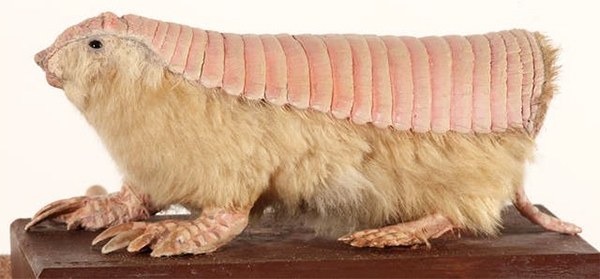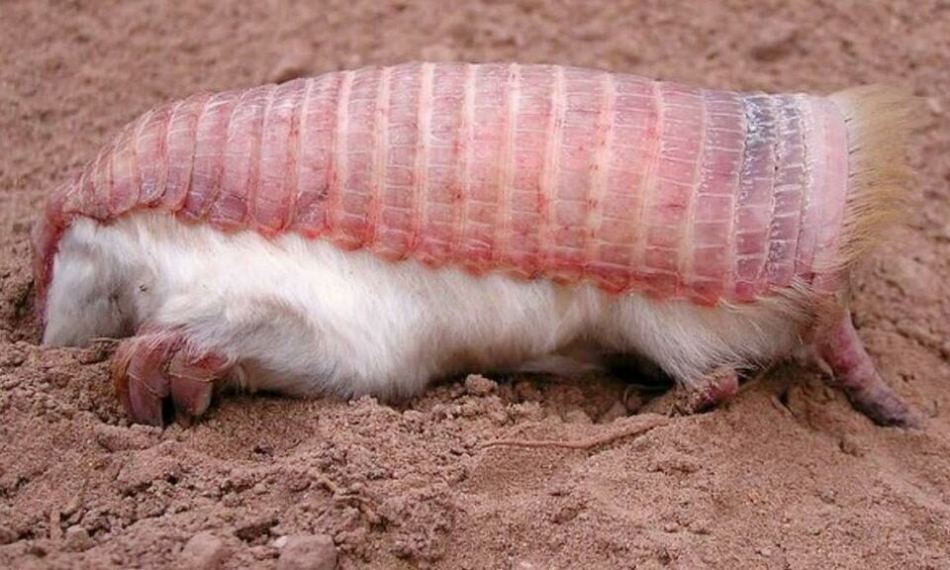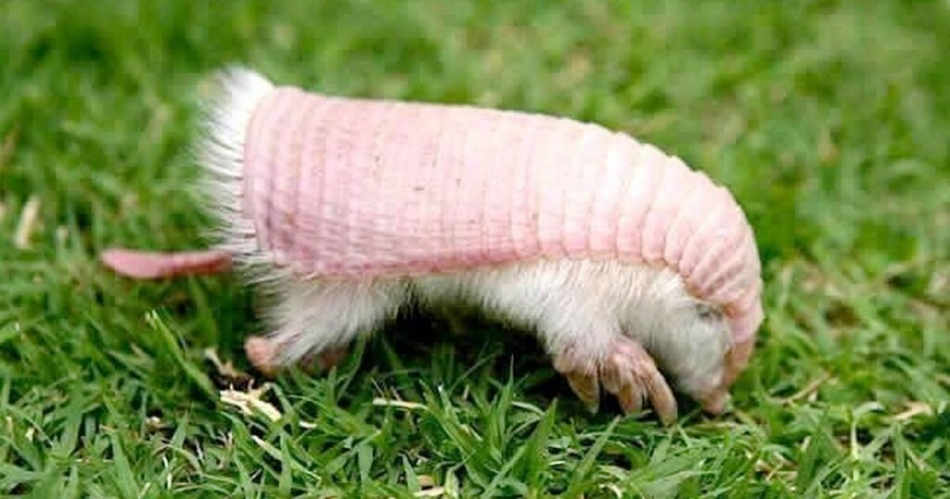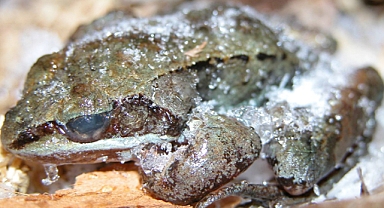Meet the Rare and Elusive Pink Fairy Armadillo
When most people think of armadillos, they picture armored mammals with tough, grayish shells. But the Pink fairy armadillo — the smallest and perhaps most enchanting of them all — defies every expectation. Officially named Chlamyphorus truncatus, this six-inch-long creature is covered in a soft, pink-hued shell and fluffy white fur underneath, looking more like a mythical being than a real animal. Despite its charming appearance, very little is known about the pink fairy armadillo. Native only to the dry grasslands and sandy plains of central Argentina, it is both nocturnal and solitary, making sightings incredibly rare. Scientists continue to be baffled by its behavior and biology. A 2012 study described them as “among the most elusive mammals,” highlighting that their nocturnal and subterranean lifestyle leaves their evolutionary history and general biology mostly unknown. What we do know is that the pink fairy armadillo is highly sensitive to changes in its environment — and cannot survive without its natural habitat.Why This Tiny Mammal Can’t Survive in Captivity
Despite its charming appearance, very little is known about the pink fairy armadillo. Native only to the dry grasslands and sandy plains of central Argentina, it is both nocturnal and solitary, making sightings incredibly rare. Scientists continue to be baffled by its behavior and biology. A 2012 study described them as “among the most elusive mammals,” highlighting that their nocturnal and subterranean lifestyle leaves their evolutionary history and general biology mostly unknown. What we do know is that the pink fairy armadillo is highly sensitive to changes in its environment — and cannot survive without its natural habitat.Why This Tiny Mammal Can’t Survive in Captivity
One of the most tragic facts about the pink fairy armadillo is its inability to adapt to captivity. Poachers sometimes smuggle them out of their habitat to be sold as exotic pets, but they rarely survive for more than eight days outside their native environment. Their delicate physiology and dependence on specific soil conditions for burrowing make them unsuited to artificial environments. Field researchers have also confirmed that these animals live alone and are rarely seen in groups, reinforcing the belief that they are intensely solitary. Their numbers have been dwindling rapidly as farmlands expand, destroying the sandy burrows they call home. Agricultural practices, like cattle grazing and pesticide use, further endanger the species by degrading soil and eliminating their insect-based food sources.Understanding the Pink Fairy Armadillo’s Lifestyle
Field researchers have also confirmed that these animals live alone and are rarely seen in groups, reinforcing the belief that they are intensely solitary. Their numbers have been dwindling rapidly as farmlands expand, destroying the sandy burrows they call home. Agricultural practices, like cattle grazing and pesticide use, further endanger the species by degrading soil and eliminating their insect-based food sources.Understanding the Pink Fairy Armadillo’s Lifestyle
The pink fairy armadillo thrives in arid regions with loose, sandy soils. Often called "sand swimmers," they can burrow rapidly through the earth thanks to their paddle-like front claws and streamlined bodies. This allows them to escape predators and extreme weather with impressive speed — up to 2 mph (3.5 kph) underground.Their pink shell is more than just an aesthetic feature. It functions as a thermal regulator, helping the armadillo manage body temperature in harsh desert climates. Despite these adaptations, their survival is closely tied to the specific conditions of central Argentina.How Long Do They Live and Can They Be Pets?
In rare, documented cases where they have survived in controlled environments, the pink fairy armadillo’s lifespan ranges from four to six years. However, this has only been observed once, and most specimens die quickly when removed from the wild. In their natural habitat, it’s believed they can live up to 10 years. Because of their extreme sensitivity and specialized needs, keeping a pink fairy armadillo as a pet is not just inadvisable — it’s unethical. Every attempt to do so has ended in failure, and removing them from their ecosystem may cause irreversible harm to the individual and the species as a whole.The Mystery of Their Communication and Behavior
These animals are not only rare but also shy and enigmatic. Much of their communication methods remain unknown. The only observed behavior in captivity involved a pink fairy armadillo running frantically and squealing when changes were made to its enclosure, possibly signaling stress or fear. This lack of knowledge adds to their mystique — and the urgency of conserving their wild populations before we lose the chance to study them further. A Species on the Brink of Disappearance
A Species on the Brink of Disappearance
With an estimated population of fewer than 100 individuals, the pink fairy armadillo is critically endangered. Because of its elusive nature and limited range, it’s difficult for researchers to gather reliable data or implement conservation strategies. Activists worldwide have rallied behind petitions urging the Argentine government to protect the armadillo's fragile ecosystem. As one Florida petitioner put it, “We must take care of this Earth and the animals on it.” Without decisive action, we may soon lose one of the planet's most unique and charming creatures.
When most people think of armadillos, they picture armored mammals with tough, grayish shells. But the Pink fairy armadillo — the smallest and perhaps most enchanting of them all — defies every expectation. Officially named Chlamyphorus truncatus, this six-inch-long creature is covered in a soft, pink-hued shell and fluffy white fur underneath, looking more like a mythical being than a real animal.
 Despite its charming appearance, very little is known about the pink fairy armadillo. Native only to the dry grasslands and sandy plains of central Argentina, it is both nocturnal and solitary, making sightings incredibly rare. Scientists continue to be baffled by its behavior and biology. A 2012 study described them as “among the most elusive mammals,” highlighting that their nocturnal and subterranean lifestyle leaves their evolutionary history and general biology mostly unknown. What we do know is that the pink fairy armadillo is highly sensitive to changes in its environment — and cannot survive without its natural habitat.Why This Tiny Mammal Can’t Survive in Captivity
Despite its charming appearance, very little is known about the pink fairy armadillo. Native only to the dry grasslands and sandy plains of central Argentina, it is both nocturnal and solitary, making sightings incredibly rare. Scientists continue to be baffled by its behavior and biology. A 2012 study described them as “among the most elusive mammals,” highlighting that their nocturnal and subterranean lifestyle leaves their evolutionary history and general biology mostly unknown. What we do know is that the pink fairy armadillo is highly sensitive to changes in its environment — and cannot survive without its natural habitat.Why This Tiny Mammal Can’t Survive in CaptivityOne of the most tragic facts about the pink fairy armadillo is its inability to adapt to captivity. Poachers sometimes smuggle them out of their habitat to be sold as exotic pets, but they rarely survive for more than eight days outside their native environment. Their delicate physiology and dependence on specific soil conditions for burrowing make them unsuited to artificial environments.
 Field researchers have also confirmed that these animals live alone and are rarely seen in groups, reinforcing the belief that they are intensely solitary. Their numbers have been dwindling rapidly as farmlands expand, destroying the sandy burrows they call home. Agricultural practices, like cattle grazing and pesticide use, further endanger the species by degrading soil and eliminating their insect-based food sources.Understanding the Pink Fairy Armadillo’s Lifestyle
Field researchers have also confirmed that these animals live alone and are rarely seen in groups, reinforcing the belief that they are intensely solitary. Their numbers have been dwindling rapidly as farmlands expand, destroying the sandy burrows they call home. Agricultural practices, like cattle grazing and pesticide use, further endanger the species by degrading soil and eliminating their insect-based food sources.Understanding the Pink Fairy Armadillo’s LifestyleThe pink fairy armadillo thrives in arid regions with loose, sandy soils. Often called "sand swimmers," they can burrow rapidly through the earth thanks to their paddle-like front claws and streamlined bodies. This allows them to escape predators and extreme weather with impressive speed — up to 2 mph (3.5 kph) underground.Their pink shell is more than just an aesthetic feature. It functions as a thermal regulator, helping the armadillo manage body temperature in harsh desert climates. Despite these adaptations, their survival is closely tied to the specific conditions of central Argentina.How Long Do They Live and Can They Be Pets?
In rare, documented cases where they have survived in controlled environments, the pink fairy armadillo’s lifespan ranges from four to six years. However, this has only been observed once, and most specimens die quickly when removed from the wild. In their natural habitat, it’s believed they can live up to 10 years. Because of their extreme sensitivity and specialized needs, keeping a pink fairy armadillo as a pet is not just inadvisable — it’s unethical. Every attempt to do so has ended in failure, and removing them from their ecosystem may cause irreversible harm to the individual and the species as a whole.The Mystery of Their Communication and Behavior
These animals are not only rare but also shy and enigmatic. Much of their communication methods remain unknown. The only observed behavior in captivity involved a pink fairy armadillo running frantically and squealing when changes were made to its enclosure, possibly signaling stress or fear. This lack of knowledge adds to their mystique — and the urgency of conserving their wild populations before we lose the chance to study them further.
 A Species on the Brink of Disappearance
A Species on the Brink of DisappearanceWith an estimated population of fewer than 100 individuals, the pink fairy armadillo is critically endangered. Because of its elusive nature and limited range, it’s difficult for researchers to gather reliable data or implement conservation strategies. Activists worldwide have rallied behind petitions urging the Argentine government to protect the armadillo's fragile ecosystem. As one Florida petitioner put it, “We must take care of this Earth and the animals on it.” Without decisive action, we may soon lose one of the planet's most unique and charming creatures.









